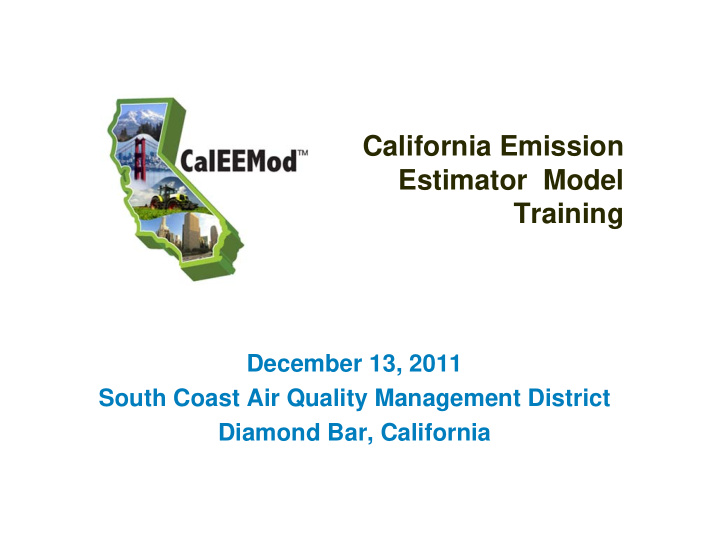



California Emission Estimator Model Training December 13, 2011 South Coast Air Quality Management District Diamond Bar, California
What is CalEEMod? • Quantifies criteria pollutants and GHG emissions • 63 land use subcategories • Applies approved emission factors, established methodology, and latest survey data • Statewide model – all 35 air districts
What is CalEEMod? • Calculates for air district, county, air basin, state level • Calculates emissions from construction and operation • Calculates direct and indirect GHG emissions (e.g., energy use, water/wastewater use, solid waste disposal, and vegetation planting and/or removal • Calculates benefits from mitigation measures
Design Specifics • Flexibility in usage � defaults allow minimal amount of required input � provides ability to insert spreadsheet for large projects (e.g., construction schedule, construction equipment list) • Regional defaults • Ability to change defaults • All equations and sources verified and documented in appendices
New Features • More GHGs • Additional land uses • Vendor trips based on the latest SMAQMD survey • New consumer product methodology • New trip rates used – maximum (daily), weighted average (annual) • Default diverted and pass-by trips included
Expected Use and Interest • Variety of applications – specific project, mixed use, plans, inventory, user defined land uses • Statewide users include: � environmental consultants � city and county planners � air quality districts � CEQA/NEPA document reviewers � developers � decision-makers • Interest expressed by National Association of Clean Air Agencies (NACAA) for national model • Accepted for GHG panel at 2012 Smart Growth Conference
The CalEEMod Story • Over 5,000 downloads since initial release • California air districts training classes • Briefings and hands on training – various organizations and government • Seven statewide “general audience” training • Online training segments being produced • Website - www.caleemod.com � Modeling files � User’s Guide � User’s Tips � Technical Paper � FAQs � Subscriber sign-up � Upcoming events
User’s Tips • Tips compiled to assist User in operation • Guidance includes: � operational information � proper modification of defaults � program limitations � program flexibility � current inconveniences/bugs • Future upgrade action on items • Tips are available online • Tips to be modified after next upgrade
Technical Paper • Provides understanding as to the development of the model • Prepared by statewide Focus Group • Highlights: � New Features � Methodology Reasoning and Differences � Default References • Available online
Importance to California Air Districts • Integrity of air quality analysis • Standardize air quality analysis • Substantial evidence supporting tool • Mitigate projects as feasibly possible • Comply with requirements (e.g., CEQA, GHG, planning, etc.) • Ensure ongoing maintenance and upgrades
Advice to Users • Calculation tool designed for range of users • Understand default information • Provide regional defaults • Utilize site specific data � traffic studies � water usage • GHG Mitigation � take advantage of criteria pollutant co-benefits • Dynamic tool; will require ongoing upgrades
Future Upgrades and Maintenance • EPA’s AP-42 emission factors for paved roads • CARB’s EMFAC2011 and updated OFFROAD emission factors • Update platform to optimize code and improve speed/model efficiency • New features (e.g., emissions from off-road equipment used in operation; energy from elevators/lighting/ventilation in parking structures) • Update any air district specific data • Functionality inconveniences (reloading issues, etc.) • Update construction profile (e.g., schedule, type, HP)
Contact Information Michael Krause Program Supervisor South Coast Air Quality Management District 21865 Copley Drive Diamond Bar, CA 91765 (909) 396-2706 mkrause@aqmd.gov
Recommend
More recommend